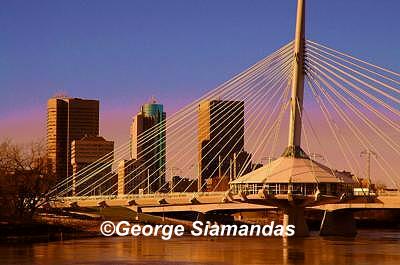

Winnipeg History
(From various sources including City of Winnipeg website)
(From various sources including City of Winnipeg website)
Winnipeg
Archeological evidence suggests that people first gathered there to trade over 6000 years ago. In 1738, Pierre de La Verendrye began the fur trading settlement at the junction of the Red and Assiniboine Rivers. The settlement, known as the Red River Colony, became a hub of the fur trade until the 1880s when grain production became more important in Western Canada. This is our story about the beginnings of our city and the historic Exchange District.
The Beginnings
In 1862 Mr. McKenny built his store where the corner of Portage and Main St. are today. In 1866 the name Winnipeg was first used for the area around Mr. McKenny's store. Winnipeg is the Cree name that means "Muddy Water". By 1872 Winnipeg had swallowed up Upper Fort Garry. People came to Winnipeg because it was close to the Hudson Bay Post. Lots of soliders came to guard the fort and many soldiers stayed to start farming. The stores began to supply settlers with seeds, tools, and glass
for houses. Farmers planted wheat and other grains. Winnipeg was the place where people bought and sold grain. People in Winnipeg bought and sold land to the settlers. By 1880 there were 57 different companies that bought and sold grain. In 1870 there were 30 buildings in Winnipeg. By 1873 there over 900 buildings in Winnipeg.
How people came to Winnipeg
The first people came by boat along the fur traders' routes from Churchill. People tried to build a wagon road from Fort William to Winnipeg but they only got 40 km. in 11 years. The Dawson Road finally was opened in 1871. Lots of people came on the railway after it opened. More buildings were built for all the people. Winnipeg became the most important city in Western Canada. Companies or banks made big buildings on Main Street. *We saw some of them on our tour of the Exchange District.
Immigration
Winnipeg needed a large, growing population. They needed to tell people in other places about Winnipeg. They put articles in newspapers and sent books about Western Canada to the libraries in Ontario. They sent a display to the Ontario Exhibition in 1882. They had a tour and lunch for Ontario reporters and train conductors so that they would tell people about Manitoba. The new city advertised in England and Europe with maps and pamphlets in 10 different languages and Exhibition vans travelled to many different countries. In 1888, the city hired immigration agents to meet the trains and encourge people to stay and farm near Winnipeg. By 1896, thousands of immigrants were coming to the west.
Growth of the city
Main St. was the most important street by 1873. Portage and Main were both very wide so the Red River carts could travel side by side and avoid the ruts. Notre Dame was supposed to be the second most important street. In 1875 Portage and Main had all of the businesses. In 1882 all of Lower Fort Garry except for one gate was torn down. In 1890 most banks were around City Hall. In 1906 a new Grain Exchange building was opened at Portage and Main. The banks moved closer to the corner too. In 1914 there were twenty-five buildings used for banking and grain business on Main just north of Portage. Many companies sold things to stores in other places. They needed warehouses with lots of space for loading and unloading so most built west of Main Street. There were also places that made clothes, cigars and stores that sold saddles (saddleries). There were more than 60 hotels between the CPR and CNR stations. In 1905, the Eaton's store was built and other stores were built on Portage
Avenue near it.
Around the early 1900 people started coming to Winnipeg for a better life. Many of the immigrants came from Europe. Some of the countries were Great Britan, Scotland, Poland, Germany, Russia, and Scandinavia.
Upon arriving to Winnipeg, immigrants had to endure many barriers and hardships. They lived in a shed for seven days with very un- pleasant conditions. Men, women, and children arrived without money, food, shelter, and most importantly without speaking a new language.
After leaving the immigration shed families were reunited with their own kind of people in other parts of the city. Beside the C.P.R. tracks in the North End. The Jewish, the Polish, Germans and Scandinavians started to make their homes. The British and the Scottish made their homes in the South End.
The immigrants needed to make a living. The men worked in heavy industry such as iron, bridge and steel factories. In 1911, 3500 men worked for the C.P.R. station. They worked very long hours at hard labour jobs for low wages. The women worked in clothing factories or sweat jobs in the Exchange District. While their children went to public school to learn English and to get an Canadian Education. The children would return home and find themselves alone until mom and dad returned from work. Many families spilt up during these hard times. But many families stayed together and continued to work hard for a better life in Winnipeg.

No comments:
Post a Comment